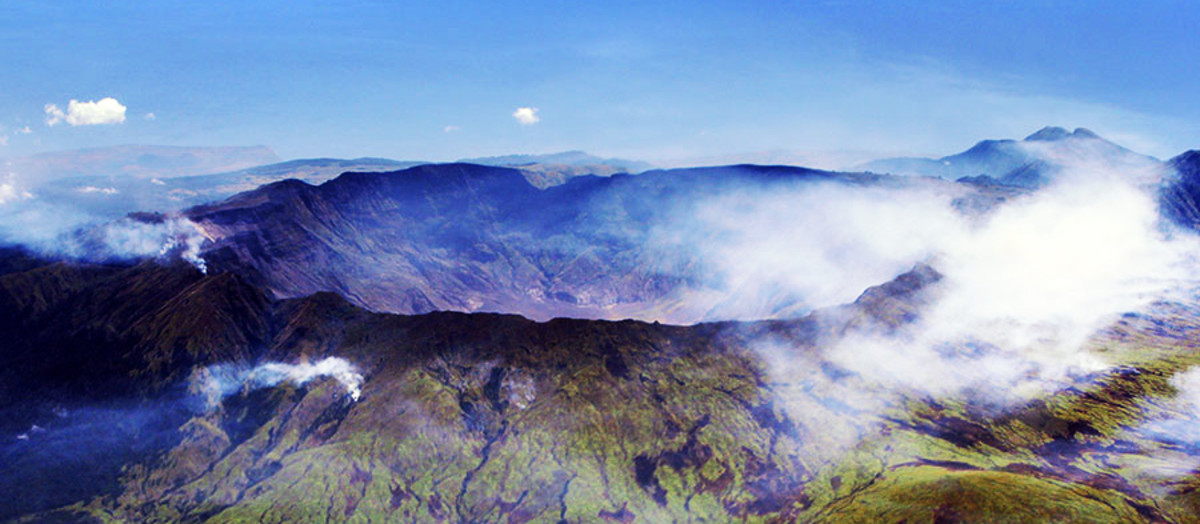Earthquake Review and Forecast for January 2016
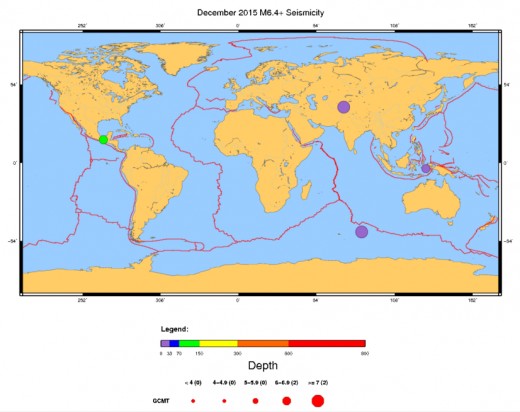

The last four months has been a story in contrasts as is shown in the table below. Worldwide significant earthquake activity (of magnitude 6.8 and above) for October and December has been no better than average, while in September and November, such seismic events surged to near record levels. In November's forecast, an exceptional window period was pointed out before the three significant earthquakes occurred that fell within its parameters. That happened to occur even while the windows in that month occupied just one third of the time during that month. No similar exceptional period was pointed out for December and, although the windows comprised 56-57 percent of that month, only one of three significant events occurred inside one of the designated window areas.
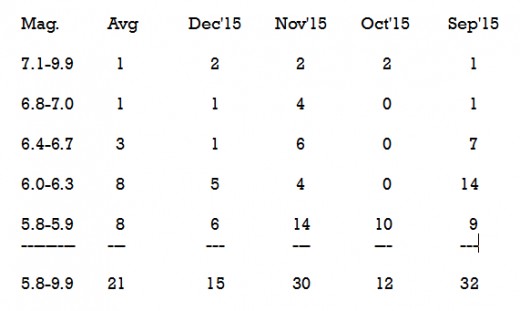
What made the difference in how astrology performed between the months of November and December was the difference in the over-all significant seismic activity. The best way to gauge the activity from month to month would seem to be by counting the number of earthquakes that registered from 6.4 to 6.7 in magnitude. In November, it was twice as active as the average and in December it was one third of the average. What threw things off and made them seem a bit more like average in December, was the two events that occurred in the 7.1 magnitude or above range (or twice the average rate of occurrence).
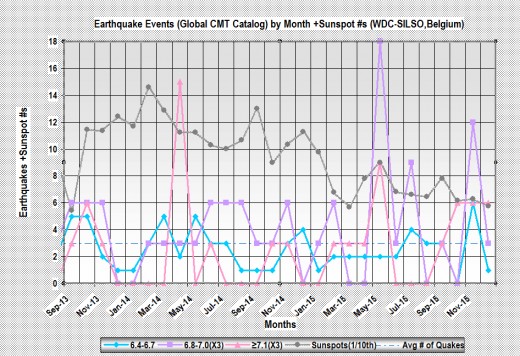
In general, my research has uncovered a period of time when significant seismic events are more prone to be aligned with astrological factors. Such times are when activity is obviously above average. But, also in general, although the larger the earthquake, the more likely they are to be related to astrological factors, if they lie outside an astrologically defined window area they are more likely to be random (even if they are above 7 in magnitude).
An average month, in the 6.8 magnitude or above category, would be two such earthquakes per month. However, this can vary from one to three a month and still be average. In December there were three such quakes. The usual breakdown has one of two such quakes in a given month as being related to astrological factors and the other one would be random. When there are three such quakes, the majority can go either way. In December, random behavior came up on top. Again, the lack of overall activity was key.
January's activity may not be any more than December's, but there are still peaks within two window periods that stand out. The first peak occurs at 0145UT on January 13th and the second peak happens at 1445UT on the 17th. It is estimated that, for 8 hours before to 16 hours after these peaks, there is at least a 2.5 times greater chance of a significant seismic event occurring than is normal. Both periods of time have potential epicenter zones in Papua New Guinea or the Solomon Islands region, Kamchatka or the Aleutian Islands region, along with Chile or Mexico. Other potential epicenter locations for the first peak relate to the Pakistan/Afghanistan/Turkmenistan areas as well as to the Peru/Colombia/Dominican Republic areas. The second peak also relates to Iran and New Zealand.
Although December 2015 did not stand out as noteworthy when it came to the amount of significant seismic activity, it did produce some results that may have raised eyebrows. For example, the event of magnitude 7.1 which happened on December 4 in the Southeast Indian Ridge zone, would seem to have been a fairly rare event (in regards to the magnitude size of the occurrence for that location; the ones that came before it in the 20th & 21st centuries have been in the 6.4-6.6 range). A less rare, but curious quake occurred two hours into the month of January 2016 (Universal Time). At that time, a magnitude 6.3 seismic event occurred in the Western Indian-Arctic Ridge, between 5 and 6 thousand kilometers east of where the earlier event happened. The largest earthquake to occur there since 1900 was a 6.9 magnitude event nine years ago and the most recent comparable event was a 6.4 magnitude shock 4.5 years ago.
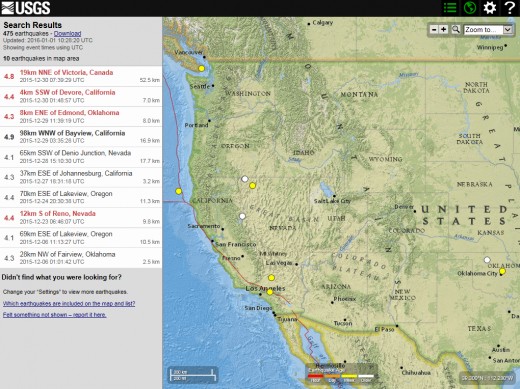
Another series of interesting events took place in the 4.1 to 4.9 magnitude range in North America as shown above. Out of the ten earthquakes with that magnitude range that occurred there, 80% happened during the week of 23 December to 30 December, with the most striking series occurring during a 20 hour period on the 29th and 30th of December. Looking at similar flare ups in the past, this could be a sign of a 7.5 magnitude or greater earthquake occurring, somewhere in the world, 3 months later or in late March 2016. Interestingly, there were two similar sized shocks in the Edmond, Oklahoma area, a 4.3 magnitude shock on 29 December followed by a 4.2 quake almost exactly 3 days later.
That last earthquake occurred during the first day of January 2016. The astrologically defined window areas for the month of January 2016, occupy 66.9% of the month. Usually, when there is such a high percentage, that is usually due to the peaks in Astro-aspect values being lower than average. As a result, it is not expected that the month will be very active (probably no more than three significant earthquakes of magnitude 6.8 or above).
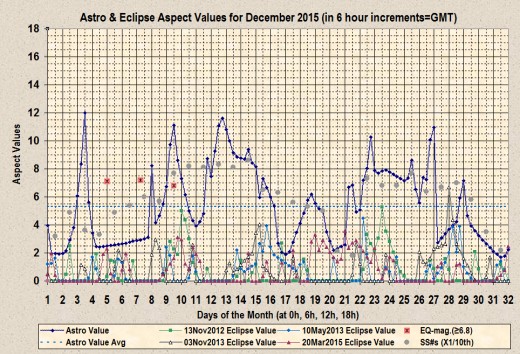
Below are the window areas and peaks within them for the month of January 2016, representing the most likely periods for worldwide earthquakes of at least 6.8 magnitude to occur. Potential epicenter locations are also given for each window.
2016-01/02.0 to 01/03.0 (24 hrs); 10% chance (normal=6.5%); peaks at 0800UT on 01/02 (value of roughly 7): Sumatra, Turkey, Nepal, India, Pakistan, Afghanistan, Turkmenistan, Iran, Iraq, Papua New Guinea, Solomon Islands.
2016-01/05.5 to 01/07.5 (48 hrs); 25% chance (normal=13%); peaks at 2000UT on 01/06 (value of roughly 9): Papua New Guinea, Solomon Islands, Iran, Kamchatka, Sumatra, Nepal, India, Iran, Iraq, Turkey.
2016-01/10.125 to 01/14.25 (4days3hrs); 70% chance (normal=27%); peaks at 0145UT on 01/13 (value=14.48): Papua New Guinea, Solomon Islands, Kamchatka, Aleutians, Pakistan, Afghanistan, Turkmenistan, Chile, Peru, Colombia, Dominican Republic, Mexico.
2016-01/15.5 to 01/16.625 (27 hrs); 10% chance (normal=7%); peaks at 0000UT on 01/16 (value=roughly 8.75): Kamchatka, Aleutians, New Zealand, southern Chile, Mexico, Papua New Guinea, Solomon Islands, Nepal.
2016-01/17.125 to 01/19.25 (2d3h); 50% chance (normal=13%); peaks at 1445UT on 01/17 (value=roughly 13.4): Papua New Guinea, Solomon Islands, Kamchatka, Aleutians, Iran, New Zealand, Chile, Mexico.
2016-01/19.875 to 01/25.25 (5d6h); 50% chance (normal=35%): Papua New Guinea, Solomon Islands, Sumatra, Nepal, India, Iran, Iraq, Pakistan, Afghanistan, Turkmenistan, Turkey.
2016-01/27.0 to end of month (5 days); 65% chance (normal=32%); peaks at 2100UT on 01/28 (value=10.5): Papua New Guinea, Solomon Islands, Iran, Iraq, Turkey, India, Nepal, Pakistan, Afghanistan, Turkmenistan.
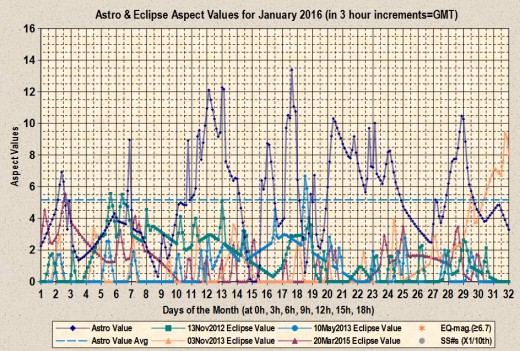
© 2016 Joseph Ritrovato






